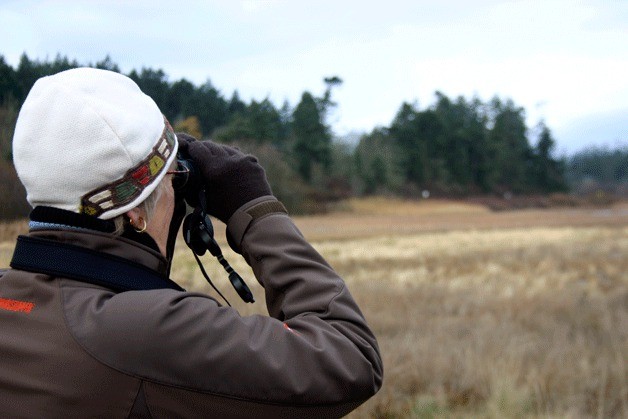Whidbey Island offers thousands of scenic locations: calm beaches backed by mountain views, water swirling under Deception Pass Bridge. But what about the life existing in these beautiful areas? The Whidbey Audubon Society offers a chance to not only see the beauty of Whidbey, but to take a closer look and help bird species during its annual North Whidbey Christmas Bird Count Saturday, Dec. 22.
Volunteers are needed and should sign up right away by emailing Jill Hein at jillhein@comcast.net. The count usually runs from 8 a.m. through 4 p.m., rain or shine. Some groups go out earlier in search of owls.
After 4 p.m., groups meet at the Pacific Rim Institute south of Coupeville to record the number of birds counted, tell stories and enjoy refreshments.
This is the 26th year for the bird count on North Whidbey but it has been a national tradition for more than 100 years and it’s the longest running wildlife census in the country, according to Susan Prescott of Whidbey Audubon. Small groups count birds in 15 sections from Crockett Lake to Deception Pass and send the numbers to the National Audubon Society, which uses the data to see what’s happening with populations of birds and determine their overall health, said Jill Hein, coordinator.
Last year, 50 volunteers counted more than 20,000 birds of 185 different species, Hein said.
“It’s really a global effort to census bird populations and it gives us the best possible long-term overview of whether populations are going up or down,” said Joe Sheldon, Whidbey Audubon member. Collecting data over 26 years is especially helpful, he added.
“As you look at the numbers you’ll see over a multiple-year period, you can spot trends,” Sheldon said, adding that this allows scientists to zero in on problems and “to try to be as good as stewards as we can.”
“In a real sense, it’s kind of like the canary in the mine,” Sheldon continued. “As the birds go, humans go. They’re an indicator of what’s happening to the ecosystem.”
“And for the non-scientists, it’s fun,” said Kim Shepard, Whidbey Audubon member. “And people who are interested in birding are fun to be with.”
“Great fellowship with great people,” Sheldon added.
“There’s nothing I love more than spending a day looking at birds, really watching birds,” said Whidbey Audubon member Sarah Schmidt. “My earliest memory is of a birdwatching trip.”
Their excitement was obvious as group members stopped mid-sentence to point out a shrike at Crockett Lake.
“They come down from the north this time of year,” Sheldon said, adding that they usually only see a few each year.
Crockett Lake is “HOLI” land as far as bird habitats go. HOLI stands for Habitat of Local Importance, Sheldon said.
“Crockett Lake is only about four feet deep at its deepest but it has an amazing variety of birds,” Shepard said. It’s a major stopping point for winter shorebirds.
 “They rely on places like this to stop and feed,” Sheldon said, calling it a “rest area” for the birds to fuel up for their next flight.
“They rely on places like this to stop and feed,” Sheldon said, calling it a “rest area” for the birds to fuel up for their next flight.
Unfortunate beginnings
The annual bird count may excite birders today, but the origins of the tradition wouldn’t. Historically, the Christmas counting tradition consisted of heading into the fields to kill as many birds as possible. The team with the most dead birds won, according to Prescott.
An officer in the budding National Audubon Society, Frank Chapman, decided to change the tradition by counting the birds and leaving them alive. The first Christmas Bird Count took place in 1900 as 27 volunteers counted birds in 25 places from Ontario to California, Prescott said. Ninety species were counted.
The Audubon members encouraged the community to get involved with the bird count.
“We’re stewards to take care of this marvelous creation and we’re responsible for keeping it healthy,” Sheldon said.
Whidbey Audubon
“Our biggest purpose is education,” Schmidt said of the Whidbey Audubon Society. “It’s centered around birds, but birds are connected to everything else.”
Whidbey Audubon holds monthly field trips, classes, meetings and hosts educational speakers. They also respond to emergencies like the sinking of the Deep Sea ship earlier this year that spilled oil into Penn Cove.
“It’s a very active organization,” Sheldon said.
For information or to get involved, visit whidbeyaudubon.org or birds.audubon.org/christmas-bird-count.


